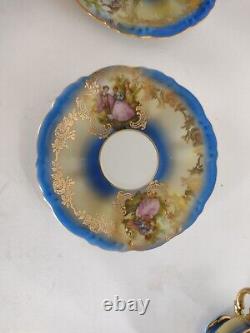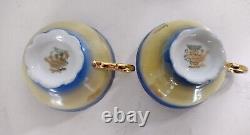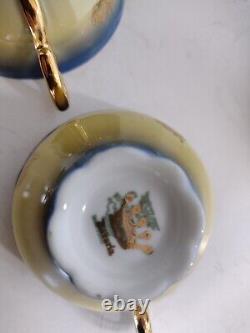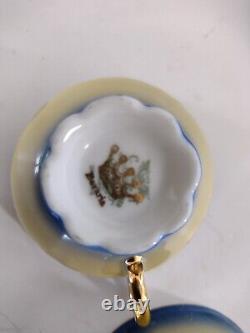
- Index
- Brand
- Aynsley (259)
- Coalport (116)
- Dresden (45)
- Haviland (109)
- Lenox (87)
- Limoges (121)
- Lomonosov (32)
- Meissen (121)
- Minton (96)
- Noritake (34)
- Paragon (225)
- Rosenthal (71)
- Royal Albert (80)
- Royal Crown Derby (87)
- Royal Doulton (41)
- Royal Worcester (96)
- Shelley (69)
- Spode (33)
- Unmarked (31)
- Wedgwood (63)
- ... (2900)
- Capacity
- Material
- Bone China (704)
- Bone China, Ceramic (4)
- Ceramic (44)
- Ceramic & Porcelain (66)
- Ceramic, Porcelain (18)
- China (6)
- Copper (13)
- Copper & Porcelain (4)
- Copper, Swarovski (10)
- Crystal (8)
- Fine Bone China (51)
- Fine China (7)
- Glass (47)
- Gold (11)
- Gold, Porcelain (10)
- Porcelain (1048)
- Porcelain / China (113)
- Porcelain, Iron (4)
- Porzellan (8)
- Stoneware (5)
- ... (2535)
- Origin
- Pattern
- Style
- Art Deco (150)
- Art Nouveau (195)
- Asian (12)
- Baroque (23)
- Classic (56)
- Contemporary (29)
- Decorative (64)
- Dresden (18)
- Edwardian (31)
- Empire (37)
- French (27)
- Georgian (62)
- Meissen / Dresden (17)
- Mid-century Modern (117)
- Neoclassical (11)
- Queen Anne (14)
- Regency (15)
- Rococo (33)
- Turkish (47)
- Victorian (256)
- ... (3502)
Antq (2)Teacups/Saucers, Gold, Scenic, 1910s, C. T, Hutschenreuther, Dresden














Antique Carl Tielsch Fine China Demitasse Teacups and Saucers. Germany Tea Cup (2)Tea Cups, Saucers, Gold Gilded, Scenic, Late 1800s-early 1900s. Originally produced by Carl Tielsch or at least has his eagle logo then stamped by Hutschenreuther and finally Dresden used their crown gold logo and stamped on top "Bavaria". I have included some of the history that I could find in what happened amongst these factories. Cups are in good condition.
Saucers are also I'm gonna od condition. One saucer has some kind of small black spot on edge. Carl Tielsch Fine China Demitasse Teacups and Saucers C. The embossing though-out the pieces adds depth and dimension to floral pattern and gold gilding. The tea cup has sweet, delicate features are rare.Carl Tielsch founded the Altwasser factory in 1845. It swiftly became second largest porcelain factory in Silesia. After twenty years the factory employeed 1,400 employees. Products of the Tielsch factory quickly became known for its high quality and artistic values. Their quality was compared to porcelain manufactures from Berlin or even Meissen.
In 1917, the name was changed to Porzellanfabrik C. One of the stockholders was Hugo Auvera who also was a director at C. The 1929 stock market crash created economic difficulties. His son Herbert replaced him on the board.
In 1932, Tielsch was acquired by C. The new firm became Porzellanfabrik Tielsch & Co, Abeilung der C. The workforce remained around 1,200 employees. During World War II, the Tielsch family fled to the west. The Russians occupied the region at the close of World War II and turned Altwasster over to the Polish government. Some portions of the factory were dismantled and sent to Russia. What remained became Polska Farbryka Porcelany Tielsh under the direction of Jan Kachniewicz.In 1952, the factory was nationalized as Zaklady Porcelany Stolowej Walbrzych. For 40 years, it was a leading porcelain manufacturing facility in Poland. In 1992 the factory became a stock company. The Polish state retained 15% of the stock. In 2007, the company became fully privatized as Fabryka Porcelany Walbrysch S.
When the factory was taken over by the Polish government in 1948, C. Hutschenreuter continued to use the Tielsch mark on pieces produced at Hutschenreuther's Azberg factory.
The company managed to get through the years of war very well until 1917. The town officials then ruled that Tielsch should reduce his capacity to 60 percent as to preserve resources.
And as to make up for the loss in income, he should also think about changing the firm into a corporation, something Egmont had been thinking about anyway. After the change in company status some well-known people became shareholders of the corporation like director Georg Faist himself. Another shareholder was the banking house run by the Arnold brothers, the Bankhaus Gebrüder Arnold in Dresden, which also owned parts of the firm of? Porzellan- und Feinsteingutfabrik Max Roesler in Rodach (Bavaria).
Finally there was Hugo Auvera, himself one of the directors from the company of C.

